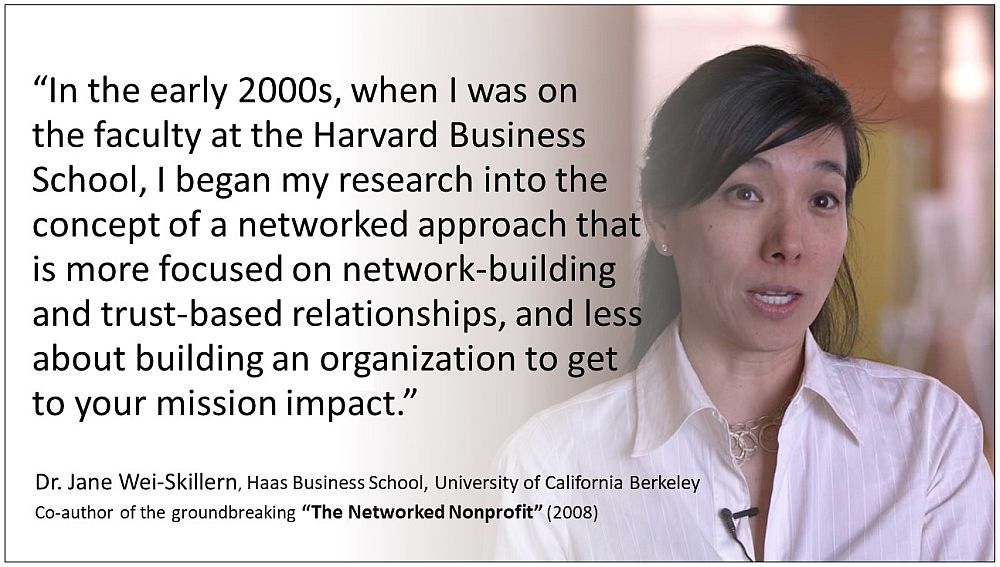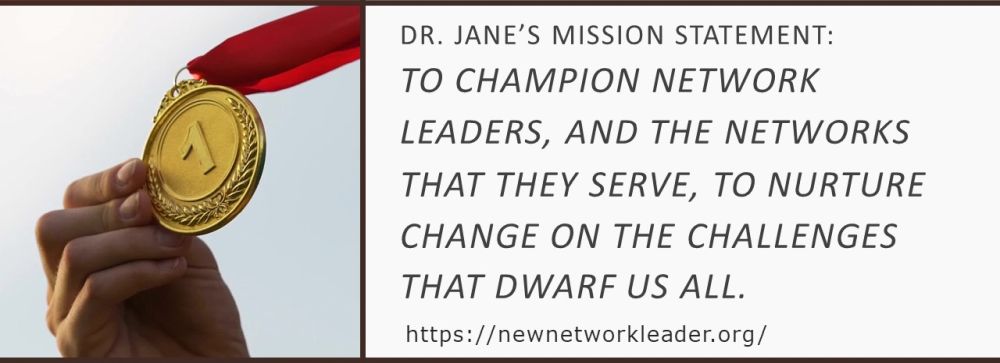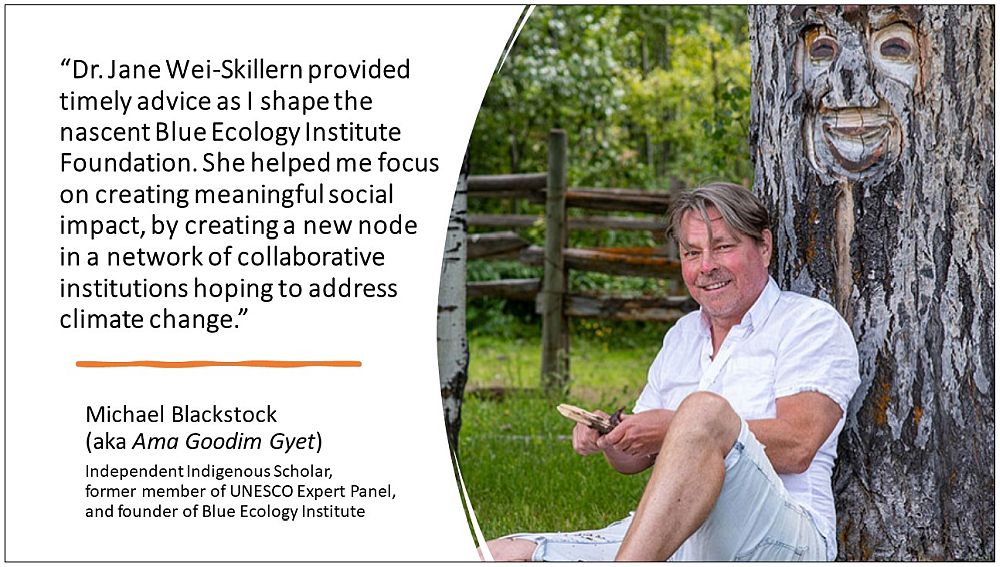LIVING WATER SMART IN BRITISH COLUMBIA: “In the early 2000s, when I was on the faculty at the Harvard Business School, I began my research into the concept of a networked approach that is more focused on network-building and trust-based relationships, and less about building an organization to get to your mission impact,” stated Dr. Jane Wei-Skillern, Haas Business School, University of California Berkeley (May 2022)
Note to Reader:
Waterbucket eNews celebrates the leadership of individuals and organizations who are guided by the Living Water Smart vision. Storylines accommodate a range of reader attention spans. Read the headline and move on, or take the time to delve deeper – it is your choice! Downloadable versions are available at Living Water Smart in British Columbia: The Series.
The edition published on May 24, 2022 featured Dr. Jane Wei-Skillern, Senior Fellow with the Haas Business School at the University of California Berkeley. Based on her case study research into the modus operandi of organizations in the nonprofit sector, she has identified four counter-intuitive guiding principles for growing effective networks.
Download a PDF copy of “Living Water Smart in British Columbia: Four counter-intuitive guiding principles for effective collaboration”.

Counter-intuitive principles for growing effective networks
Focus on mission before organization. Effective network leaders build strategies that advance the mission even when it does not result in direct benefits to their organization.
Build partnerships based on trust, not control. Leaders depend upon shared values and trust rather than top-down controls and accountability systems.
Promote others rather than yourself. Network leaders exhibit a strong norm of humility above all else, sharing credit and foregoing opportunities for individual advancement and institutional growth and brand building.
Build constellations rather than lone stars. Leaders who catalyze successful networks acknowledge their weaknesses as readily as their strengths. The goal is to build the larger system that is necessary for delivering on the mission, not to become the “market leader”.

Growing the network is all about a culture change
From the outset, the Partnership for Water Sustainability has vowed never to fall into the trap of concentrating our energies on building an organization and thus losing sight of “the mission”. This view of the world reflects the Partnership’s inter-governmental genesis and history of success as a “convening for action” roundtable.
Stay true to the mission
The Partnership mission is to grow the Living Water Smart Network, promote consistent application of science-informed understanding to improve land use and infrastructure servicing practices, and help BC communities align efforts around a vision for “settlement, economy and ecology in balance”.
Members of the Partnership leadership team are often asked, why the singular focus on “the network” in the context of collaborative leadership? We are fortunate to have connected with Dr. Jane Wei-Skillern. Her groundbreaking research into the concept of “networked nonprofits” shines light on why we do what we do. She has provided us with a framework to explain what is intuitive and therefore a leap of faith for the Partnership.

Story behind the story
It was a year ago that we first introduced readers of Waterbucket eNews to “Dr. Jane” and her four Counter-Intuitive Principles for Effective Networks when the Partnership published Living Water Smart in British Columbia: The Power of Collaborative Leadership on June 1, 2021. The story featured a conversation between Derek Richmond and Mike Tanner, two Partnership Directors. In the conversation, they reflected on the four principles as measures of success.
In this edition, we report out on a follow-up conversation with Dr. Jane. It is the “story behind the story”. Dr. Jane explains the origin of her passion, and why her personal mission is to champion and support network leaders like the Partnership for Water Sustainability.

EDITOR’S PERSPECTIVE
“The late, great Erik Karlsen (1945-2020), a former Director in the Ministry of Municipal Affairs and a Past-Chair (2005-2010) of the Agricultural Land Commission, was one of the architects of the network-based model that drives the ‘convening for action’ mission of the Partnership for Water Sustainability. Erik was a ‘change agent’ in every sense of the word, made his mark on so many fronts, and was respected throughout,” stated Kim Stephens, Waterbucket eNews Editor and Partnership Executive Director.
“It was Erik Karlsen who first observed that we were building a ‘management architecture for collaboration’ and that our approach was entirely intuitive. Ergo, he said, an essential element of the mission is to explore the research in sociology and psychology to find precedents that would help us explain what we do intuitively. This is our context for reaching out to Dr. Jane Wei-Skillern.”
“Guided by Erik Karlsen’s wisdom, Mike Tanner discovered the work of ‘Dr. Jane’. As an academic and researcher, she is a true gem and is an inspiration to the Partnership. Jane Wei-Skillern is passionate about her research, so much so that she has taken a leave of absence from teaching to focus her time and efforts on the ‘practitioner space’, as she describes it.”
“Dr. Jane builds bridges to network leaders. She champions and supports what they do because she believes in the value of what they do. When you have a conversation with Jane, her enthusiasm and commitment leave an indelible impression. This will be evident to the reader once you scroll down and read testimonials from several British Columbians.”
Collaborative leadership is commitment to something bigger
“Collaborative leadership uses the power of influence rather than positional authority to engage and align individuals and organizations within a network and deliver results across organizational boundaries,” continued Kim Stephens.
“The network is the ultimate source of strength of the Partnership. The network also holds the key to intergenerational collaboration. It is how we build bridges of understanding and pass the baton from the past to the present and future.”
“If the Partnership for Water Sustainability is to be successful in facilitating changes in practice over the long-term, then the hard work must be done by our partners. This means the work of the Partnership must be aligned with and support their organizational aspirations and objectives.”

Excerpts from a conversation with Dr. Jane Wei-Skillern: The “story behind the story” of four Counter-Intuitive Principles
To open the conversation with Dr. Jane, Derek Richmond stated that, “We needed to find some research that says what we are doing has been done before. We found you, Jane!”
Mike Tanner built on Derek’s statement with this observation, “After reading your paper and reflecting on my lifetime of experience with professional associations and non-profits, it strikes me that so many organizations have been around a long time but are doing it wrong.”
“With our mission-centric focus, we believe the Partnership is doing it right,” added Derek Richmond. “But now our challenge is to sustain the momentum through a succession process within the network. We are looking to you, Jane, for inspiration that will guide us through the next phase in the Partnership’s evolution.”

The impact of the network’s collective work is dramatically greater than the sum of the individual parts
Derek and Mike’s comments prompted this response from Dr. Jane: “I am always eager to find others who are working in this way and support them in any way that I can. Every so often I check to find out what is going on in the network space and saw the Partnership’s great work and how you are getting great impacts through the Living Water Smart Network.”
“When I reached out to the Partnership, I thought I am thrilled to see that they are using my work. And maybe I can support them in their efforts because I love to see people doing this – because I know it works. The frustration for me is that there aren’t more people doing it.”

Knock down barriers
“I find that many people who are network leaders are often swimming upstream, struggling, and fighting an uphill battle. That is such a waste of time and energy. They are the unsung heroes, who should be free to catalyze and build the network to get the work done without so many senseless barriers getting in of the way.”
“Much of the work that I am doing is with an eye toward how we remove those barriers that are keeping people from building thriving networks.”

To learn more about Adriane Pollard, download a PDF copy of Living Water Smart in British Columbia: The Role of the Municipal Champion as the Interpreter.
Build a network to get to your mission impact
“Because I studied sociology and psychology as a doctoral student, I had some background in network theory. Then, when I was looking for a research topic as a junior faculty member at the Harvard Business School in the early 2000s, there was much interest in how we grow non-profits.”
“How do we engage in social entrepreneurship; how do we grow new innovations to scale? That was the focus, and all the faculty were excited about these questions. A common approach was to take what we understood about the private sector, tweak it a little, and apply it to the non-profit sector.”

|

To learn more about Joe McGowan, download a PDF copy of Living Water Smart in British Columbia: A Network Allows People to Move Out of Workplace Silos.
The networked approach is advancing a culture change in the “social impact space”
“The leaders who work in this way are really competent in what they do. They have great people skills, they are good organisational managers, and they are good at seeing the big picture and identifying where they need to engage others and build the network to solve the problem.”
“My research became an obsession, a focus, and a passion. Yet most of my colleagues did not think this was interesting or relevant – because it was very different from what they were doing. I did not get a whole lot of support, but I just kept doing it.”
“To follow my passion, I have taken a leave from teaching and focused on the practitioner space. I have seen tremendous interest from practitioners like the Partnership who appreciate having a framework to articulate what they are doing. Many of the people who lead in this way have done it intuitively.”

A commitment to the mission
“So, really, I have embarked on a culture change in the social impact space. Not on my own. That is why I am always trying to network with others who are of like mind, to try to move this forward – because I truly believe this is the way we as human beings will change the world. We must let go of traditional models of working.”
“Advancing this agenda requires a different mindset, a different way of working, and most importantly, a commitment to something bigger than ourselves and our organizations,” concludes Dr. Jane Wei-Skillern.

To learn more about Michael Blackstock, download a PDF copy of Living Water Smart in British Columbia: Oral history extends the period of record and our understanding of what the data mean.
Did you enjoy this article? Would you like a PDF document version? Click on the image below to download your copy.
DOWNLOAD A PDF COPY: https://waterbucket.ca/wcp/wp-content/uploads/sites/6/2022/05/PWSBC_Living-Water-Smart_grow-the-network_2022.pdf


